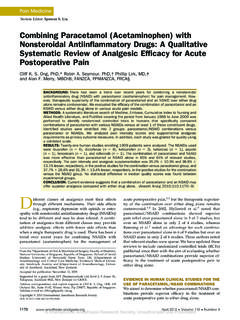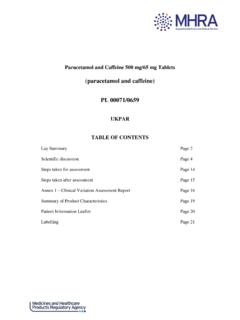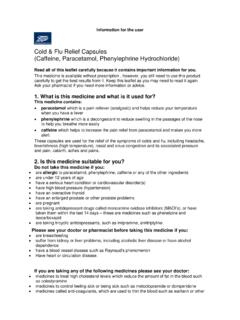Transcription of PARACETAMOL + CODEINE 1. Product Name 2. …
1 Page 1 of 10 NEW ZEALAND DATA SHEET PARACETAMOL + CODEINE 1. Product Name PARACETAMOL + CODEINE , 500 mg + 8 mg, tablets. 2. Qualitative and Quantitative Composition Each PARACETAMOL + CODEINE contains 500 mg of PARACETAMOL and 8 mg of CODEINE phosphate. For the full list of excipients, see section 3. Pharmaceutical Form PARACETAMOL + CODEINE tablets are round white bevel edged tablets, 13 mm in diameter and 4 mm thick, with MYL on one side and P above the breakline and C below the breakline on the other side. The tablet can be divided into equal doses. 4. Clinical Particulars Therapeutic indications For adults and children aged 12 years and above for effective, temporary relief of pain and discomfort associated with: headache migraine headache tension headache period pain back pain muscle pain arthritis toothache dental procedures neuralgia sore throat cold and flu symptoms in adults only (18 years and older) PARACETAMOL + CODEINE tablets also help reduce fever.
2 PARACETAMOL + CODEINE is suitable for asthmatics sensitive to aspirin and NSAIDs. Page 2 of 10 Dose and method of administration Dose Adults and children over 12 years: 1 to 2 tablets every 4 - 6 hours as required. Maximum of 8 tablets in 24 hours. Contraindications Use in patients with known hypersensitivity or idiosyncratic reaction to PARACETAMOL , CODEINE , other opiates or any of the excipients listed in section In children aged less than 12 years old. PARACETAMOL + CODEINE is also contraindicated for use in patients: with severe hepatic insufficiency with acute respiratory depression with chronic constipation during labour when delivery of a premature infant is anticipated as it may produce CODEINE withdrawal symptoms in the neonate who are breastfeeding with active alcoholism with diarrhoea caused by pseudomembranous colitis or poisoning (until the causative organism or toxin has been eliminated from the gastrointestinal tract, since CODEINE may slow down the elimination, thereby prolonging the diarrhoea).
3 Who are known to be CYP2D6 ultra-rapid metabolisers aged below 18 years of age who have undergone tonsillectomy and/or adenoidectomy to treat obstructive sleep apnoea, as these patients are more susceptible to respiratory adverse reactions. aged below 18 years old in whom respiratory function might be compromised (see section ) aged below 18 years old for the symptomatic treatment of cough and or cold (see section ) Also refer to section Special warnings and precautions for use PARACETAMOL + CODEINE should be used with caution in patients with: decreased respiratory reserve asthma or chronic obstructive pulmonary disease (COPD) pre-existing respiratory depression raised intracranial pressure or head injury prostatic hypertrophy hypotension hypothyroidism adrenocortical insufficiency It should also be used with caution in patients who.
4 Have a history of drug abuse are taking other respiratory depressants or sedatives, including alcohol have had recent gastrointestinal tract surgery Page 3 of 10 PARACETAMOL + CODEINE should be used with the utmost caution and in reduced doses in patients with: severely impaired kidney function impaired liver function or alcoholism CODEINE may obscure the diagnosis or the course of gastrointestinal diseases. Prolonged use of CODEINE may produce physical and psychological dependence. Where analgesics are used long-term (>3 months) with administration every two days or more frequently, headache may develop or worsen. Headache induced by overuse of analgesics (MOH medication-overuse headache) should not be treated by dose increase. In such cases, the use of analgesics should be discontinued in consultation with the doctor.
5 CYP2D6 metabolism CODEINE is metabolised by the liver enzyme CYP2D6 into morphine, its active metabolite. If a patient has a deficiency or is completely lacking this enzyme an adequate analgesic effect will not be obtained. Estimates indicate that up to 7% of the Caucasian population may have this deficiency. However, if the patient is an extensive or ultra-rapid metaboliser there is an increased risk of developing side effects of opioid toxicity even at commonly prescribed doses. These patients convert CODEINE into morphine rapidly resulting in higher than expected serum morphine levels. General symptoms of opioid toxicity include confusion, somnolence, shallow breathing small pupils, nausea, vomiting, constipation and lack of appetite. In severe cases this may include symptoms of circulatory and respiratory depression, which may be life threatening and very rarely fatal.
6 Concomitant use with benzodiazepines Profound sedation, respiratory depression, coma, and death may result from the concomitant use of PARACETAMOL + CODEINE with benzodiazepines or other CNS depressants ( , non-benzodiazepine sedatives/hypnotics, anxiolytics, tranquilizers, muscle relaxants, general anaesthetics, medicines with antihistamine-sedating actions such as antipsychotics, other opioids, alcohol). Because of these risks, reserve concomitant prescribing of these drugs for use in patients for whom alternative treatment options are inadequate. Observational studies have demonstrated that concomitant use of opioid analgesics and benzodiazepines increases the risk of medicine-related mortality compared to use of opioid analgesics alone. Because of similar pharmacological properties, it is reasonable to expect similar risk with the concomitant use of other CNS depressant drugs with opioid analgesics (see section ).
7 If the decision is made to prescribe a benzodiazepine or other CNS depressant concomitantly with an opioid analgesic, prescribe the lowest effective dosages and minimum durations of concomitant use. In patients already receiving an opioid analgesic, prescribe a lower initial dose of the benzodiazepine or other CNS depressant than indicated in the absence of an opioid, and titrate based on clinical response. If an opioid analgesic is initiated in a patient already taking a benzodiazepine or other CNS depressant, prescribe a lower initial dose of the opioid analgesic, and titrate based on clinical response. Follow patients closely for signs and symptoms of respiratory depression and sedation. Advise both patients and caregivers about the risks of respiratory depression and sedation when PARACETAMOL + CODEINE is used with benzodiazepines or other CNS depressants (including alcohol and illicit drugs).
8 Advise patients not to drive or operate heavy machinery until the effects of concomitant use of the benzodiazepine or other CNS depressant have been determined. Screen patients for risk of substance use disorders, including opioid abuse and misuse, and warn them of Page 4 of 10 the risk for overdose and death associated with the use of additional CNS depressants including alcohol and illicit drugs (see section ). Special populations Post-operative use in children There have been reports in the published literature that CODEINE given post-operatively in children after tonsillectomy and or/adenoidectomy for obstructive sleep apnoea, led to rare, but life-threatening adverse events including death. All children received doses of CODEINE that were within the appropriate dose range; however, there was evidence that these children were either ultra-rapid or extensive metabolisers in their ability to metabolise CODEINE to morphine.
9 Children and adolescents with compromised respiratory function CODEINE is not recommended for use in children and adolescents aged less than 18 years in whom respiratory function might be compromised, including neuromuscular disorders, severe cardiac or respiratory conditions, upper respiratory or lung infections, multiple trauma or extensive surgical procedures. These factors may worsen symptoms of morphine toxicity. Elderly The elderly are more likely to have age-related renal impairment and may be more susceptible to the respiratory effects of opioid analgesics. Dose reduction may be required. Effects on laboratory tests Plasma amylase and lipase activity CODEINE may cause increased biliary tract pressure, thus increasing plasma amylase and/or lipase concentrations. Gastric emptying studies Gastric emptying is delayed by CODEINE so gastric emptying studies will not be valid.
10 Interaction with other medicines and other forms of interaction Salicylates and NSAIDs Prolonged concurrent use of PARACETAMOL and salicylates or non-steroidal anti-inflammatory drugs may increase the risk of adverse renal effects. Coumarins Concomitant use of warfarin (and other coumarin anticoagulants) and PARACETAMOL may increase the risk of bleeding. Chloramphenicol PARACETAMOL may slow down the excretion of chloramphenicol, entailing the risk of increased toxicity. Diflusinal Diflunisal may increase the plasma concentrations of PARACETAMOL by 50%. Anticholinergics Concomitant use of CODEINE and anticholinergic agents may increase the risk of severe constipation and/or urinary retention. Drugs, which decrease gastric emptying, may decrease the absorption of PARACETAMOL . Cholestyramine Cholestyramine reduces the absorption of PARACETAMOL if given within one hour of PARACETAMOL administration.















